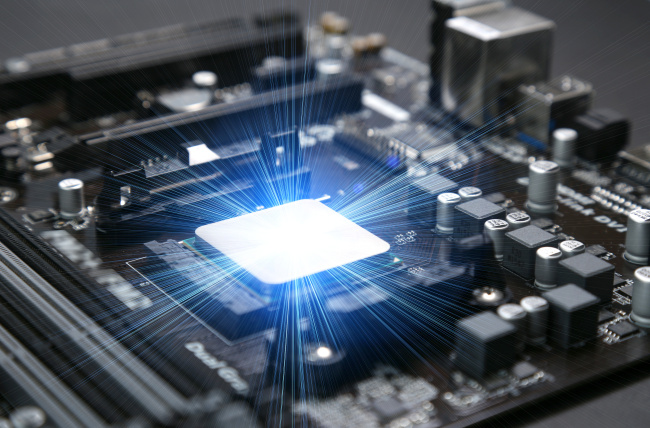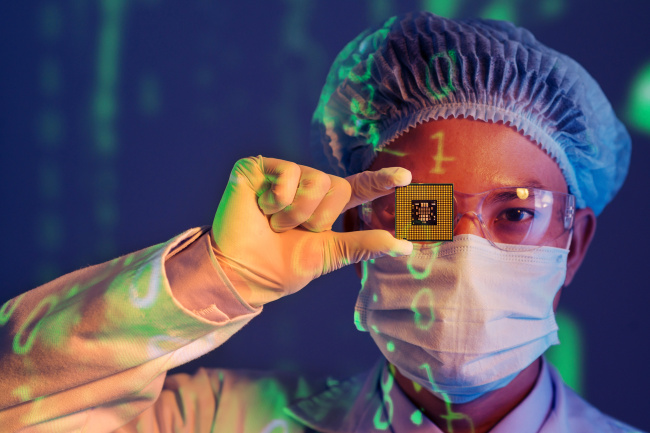The Korea Herald is publishing a series of articles analyzing the drives and challenges in the non-memory chip market. -- Ed.
After a couple of record-breaking years for the semiconductor sector, pessimistic forecasts have quickly dampened the mood, as memory chips enter a downward cycle, leading South Korea to shift its focus to alternative exports.
With Korea’s rickety lead in the global race for 5G networks, it has become imperative for the country to secure a presence in another key artificial intelligence sector -- non-memory chips.
Although it has gained a reputation as the world’s biggest memory chip provider with a market share of over 60 percent, Korea’s presence in the non-memory market has been weak with a mere 5 percent share. This has recently prompted concerns about its competitiveness in a market that is deemed crucial for taking a lead in AI and 5G.
The need for Korean chipmakers to shift the focus from memory to non-memory chips is stronger than ever, according to not only industry insiders but also the government, as the global memory chip market has entered a downward cycle and prices in the sector have come down.
President Moon Jae-in most recently ordered immediate measures to raise the domestic semiconductor industry’s competitiveness in the non-memory field at a state affairs meeting, saying, “Measures are needed to reduce the country’s overreliance on the memory chip market.”
 |
(123RF) |
This is not the first time the president has mentioned non-memory chips this year. In January, he directly asked Samsung Vice Chairman Lee Jae-yong about the company’s expansion into the non-memory sector during a chat at Cheong Wa Dae after a formal discussion on economic issues with the business community.
The discussion about the non-memory challenge is getting more serious as the slowdown in the memory market started to take a toll on Korea’s overall export performance.
According to the Korea Customs Service, the country’s exports in the first 20 days this month dropped 4.9 percent from a year earlier, led by a 25 percent decline in semiconductor exports.
Semiconductor exports account for a fifth of Korea’s total exports, but they have been on the wane for four straight months. Because about 90 percent the Korean chip exports are in the memory segment, recent decreases in prices are also reducing the total value of exports.
What are non-memory chips?
Of the overall semiconductor industry, memory chips -- largely defined by DRAM and NAND flash -- that are used for storing data in electronic devices only account for about 10 percent. The remaining 90 percent are non-memory chips whose types and applications vary so much that they can’t all be named.
System-on-chips make up approximately 70 percent of the non-memory market. SoCs refer to a variety of integrated circuits consisting of components such as control units, memory blocks, timing units and interfaces mounted on a single chip. They are designed to accelerate the processing of data.
The central processing unit is the most well-known type of SoC, and is used in PCs, mobile gadgets and servers. And as a huge number of home appliances are starting to be connected with communications devices, similar processors are going into a greater variety of home electronics products, as well as automobiles.
Other types of non-memory products include communications chipsets, image sensors, power management chips, display driver chips and smart card chips.
While US tech moguls Intel and Qualcomm dominate the CPU and mobile application processor markets respectively, Japan’s Sony leads the image sensor market.
Where does Korea stand?
Korean chip giant Samsung, the world’s largest memory chip manufacturer, has been seeking to expand into the mobile AP and image sensor markets.
It is the fourth-largest player in the mobile AP market as of September 2018, with an 11 percent market share, according to data by Strategy Analytics. It comes second in the image sensor market after Sony with about 30 percent share as of last year.
“Samsung has been focusing on the memory business as part of its efforts to allocate limited resources efficiently on areas that have a high probability of success, and that is the most urgent (thing),” said a company official. “The company still believes that demand for memory chips will continue growing in the AI and 5G era, but at the time same, there is an acknowledgement that the company will need to discover new sources of profit in the non-memory sector, because the market is less sensitive to market cycles.”
Samsung heir Lee has vowed to snatch the top spot in the non-memory market, including the fabless and foundry businesses, by 2030.
The Korean tech titan is eyeing the automotive semiconductor market, which is forecast to see an explosive growth when autonomous driving technologies are ready for commercialization.
In January, Lee told the president, “The non-memory business is all about making the right target and then focusing on it.”
He noted that Korean chipmakers are in need of the so-called “selection and concentration strategy” in their exploration of a new market.
“In order to become a strong player in the vast non-memory chip market, Samsung and SK hynix will need to be able to predict what technologies will go mainstream in the next five or 10 years, what applications will run on those technologies, and choose one that is forecast to be the most successful,” said an executive at a US-based system-on-chip company. “Then, don’t hesitate to invest in the long term in developing a system IC that will work perfectly on that application.”
 |
(123RF) |
SK hynix, the second-largest player in the global memory market after Samsung, has so far remained silent about its non-memory business, shy of revealing the reality of its small business in the image sensor market.
According to market researcher TSR, the company claimed a 9.9 percent market share in the first quarter of 2018. But its image sensor sales -- at 800 billion won ($706 million) -- accounted for a mere 1 percent of the company’s total sales last year.
“The company’s non-memory business is too small to be mentioned,” said an SK hynix official. “About 98 percent to 99 percent of the company’s sales rely on memory chips.”
Unlike Samsung that operates its own foundry business within the semiconductor division, SK hynix’s foundry business is separately run by its subsidiary SK hynix System IC.
Samsung is the world’s second-largest foundry player with a 19.1 percent market share, behind Taiwan’s TSMC with a 48.1 percent share, while SK hynix’s foundry business is yet to enter the top 10.
By Song Su-hyun (
song@heraldcorp.com)









